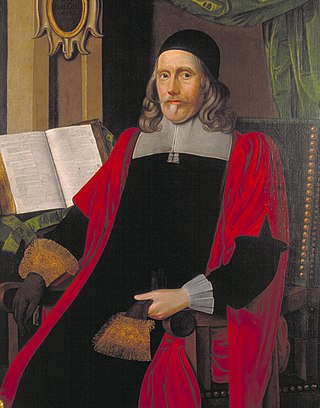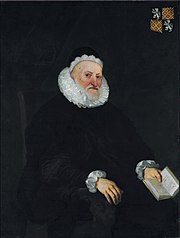
Charles I was King of England, Scotland, and Ireland from 27 March 1625 until his execution in 1649.

Sir Matthew Hale was an influential English barrister, judge and jurist most noted for his treatise Historia Placitorum Coronæ, or The History of the Pleas of the Crown.

Sir Edward Coke was an English barrister, judge, and politician. He is often considered the greatest jurist of the Elizabethan and Jacobean eras.

The Petition of Right, passed on 7 June 1628, is an English constitutional document setting out specific individual protections against the state, reportedly of equal value to Magna Carta and the Bill of Rights 1689. It was part of a wider conflict between Parliament and the Stuart monarchy that led to the 1638 to 1653 Wars of the Three Kingdoms, ultimately resolved in the 1688-89 Glorious Revolution.

John Selden was an English jurist, a scholar of England's ancient laws and constitution and scholar of Jewish law. He was known as a polymath; John Milton hailed Selden in 1644 as "the chief of learned men reputed in this land".

Anthony Ashley Cooper, 1st Earl of Shaftesbury PC, FRS, was an English statesman and peer. He held senior political office under both the Commonwealth of England and Charles II, serving as Chancellor of the Exchequer from 1661 to 1672 and Lord Chancellor from 1672 to 1673. During the Exclusion Crisis, Shaftesbury headed the movement to bar the Catholic heir, James II, from the royal succession, which is often seen as the origin of the Whig party. He was also a patron of the political philosopher John Locke, with whom Shaftesbury collaborated with in writing the Fundamental Constitutions of Carolina in 1669.

Sir James Whitelocke SL was an English judge and politician who sat in the House of Commons between 1610 and 1622.

The Exclusion Crisis ran from 1679 until 1681 in the reign of King Charles II of England, Scotland and Ireland. Three Exclusion Bills sought to exclude the King's brother and heir presumptive, James, Duke of York, from the thrones of England, Scotland and Ireland because he was Catholic. None became law. Two new parties formed. The Tories were opposed to this exclusion while the "Country Party", who were soon to be called the Whigs, supported it. While the matter of James's exclusion was not decided in Parliament during Charles's reign, it would come to a head only three years after James took the throne, when he was deposed in the Glorious Revolution of 1688. Finally, the Act of Settlement 1701 decided definitively that Catholics were to be excluded from the English, Scottish and Irish thrones, now the British throne.
The Personal Rule was the period in England from 1629 to 1640 when King Charles I ruled as an autocratic absolute monarch without recourse to Parliament. Charles claimed that he was entitled to do this under the royal prerogative and that he had a divine right.

Sir Nicholas Hyde was Lord Chief Justice of England.

Sir Robert Heath was an English judge and politician who sat in the House of Commons from 1621 to 1625.

Sir John Bourchier or Bourcher was an English landowner and Puritan radical, who supported the Parliamentarian cause during the Wars of the Three Kingdoms. A regicide who voted for the Execution of Charles I in January 1649, he died in August 1660 awaiting trial following the Stuart Restoration.

Richard Knightley was an English lawyer and politician, who was a Member of Parliament, and Sheriff of Northamptonshire in 1626.
Sir Francis Barrington, 1st Baronet of Barrington Hall, Essex was a Puritan activist and politician, who was MP for Essex from 1601 to 1604, then 1620 to 1628.

Roger Maynwaring, variously spelt Mainwaring or Manwaring, was a bishop in the Church of England, censured by Parliament in 1628 for sermons seen as undermining the law and constitution.
Sir Thomas Darnell, 1st Baronet was an English landowner, at the centre of a celebrated state legal case in the reign of Charles I of England, often known as the 'Five Knights' Case' but to the lawyers of the period Darnell's Case.
Benjamin Valentine, was an English politician and Member of Parliament.
Sir Henry Calthorpe (1586–1637), was an English lawyer who acted as solicitor-general to Queen Henrietta Maria, and also as the defence barrister in two high-profile cases: the Darnell's Case and the Valentine case. He was Recorder of London in 1635–36, attorney of court of wards in 1636, and was knighted the same year.

The 3rd Parliament of King Charles I was summoned by King Charles I of England on 31 January 1628 and first assembled on 17 March 1628. The elected Speaker of the House of Commons was Sir John Finch, the Member of Parliament for Canterbury.
Sir Edmund Hampden was an English landowner, at the centre of a celebrated state legal case in the reign of Charles I of England, known as the Five Knights' Case or Darnell's Case.













